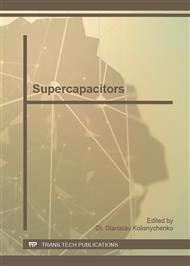p.299
p.305
p.309
p.315
p.320
p.325
p.331
p.337
p.343
Printed Supercapacitor as Hybrid Device with an Enzymatic Power Source
Abstract:
Low cost printable power sources are needed e.g. in sensors and RFID applications. As manufacturing method printing techniques are preferred in order to keep the costs low. The materials should also be easily disposable. Enzymatic bio-fuel cells are an alternative for printable primary batteries. Since one drawback of bio-fuel cells is their low power, we have developed supercapacitors that can be combined with enzymatic bio-fuel cells to provide the power peaks necessary in the applications. The materials for the supercapacitors have been chosen to be compatible with the fuel cell and with printing methods, e.g. the activated carbon powder in the electrodes was bound with chitosan. As printing substrates we have used paperboards. The current collectors have been made of graphite and metal inks. Since the voltage requirement is limited to approximately 1 V, aqueous electrolytes have been used. Printed supercapacitors of various sizes have been prepared. The geometrical electrode areas have been between 0.5 and 2 cm2. The maximum feasible output current has been in the order of 50 mA corresponding to about 50 mW power. When the capacitor is used together with an enzymatic power source, the leakage current must be as low as possible. Typical leakage current values have been in the order of 10 µA.
Info:
Periodical:
Pages:
331-336
Citation:
Online since:
October 2010
Price:
Сopyright:
© 2010 Trans Tech Publications Ltd. All Rights Reserved
Share:
Citation:



